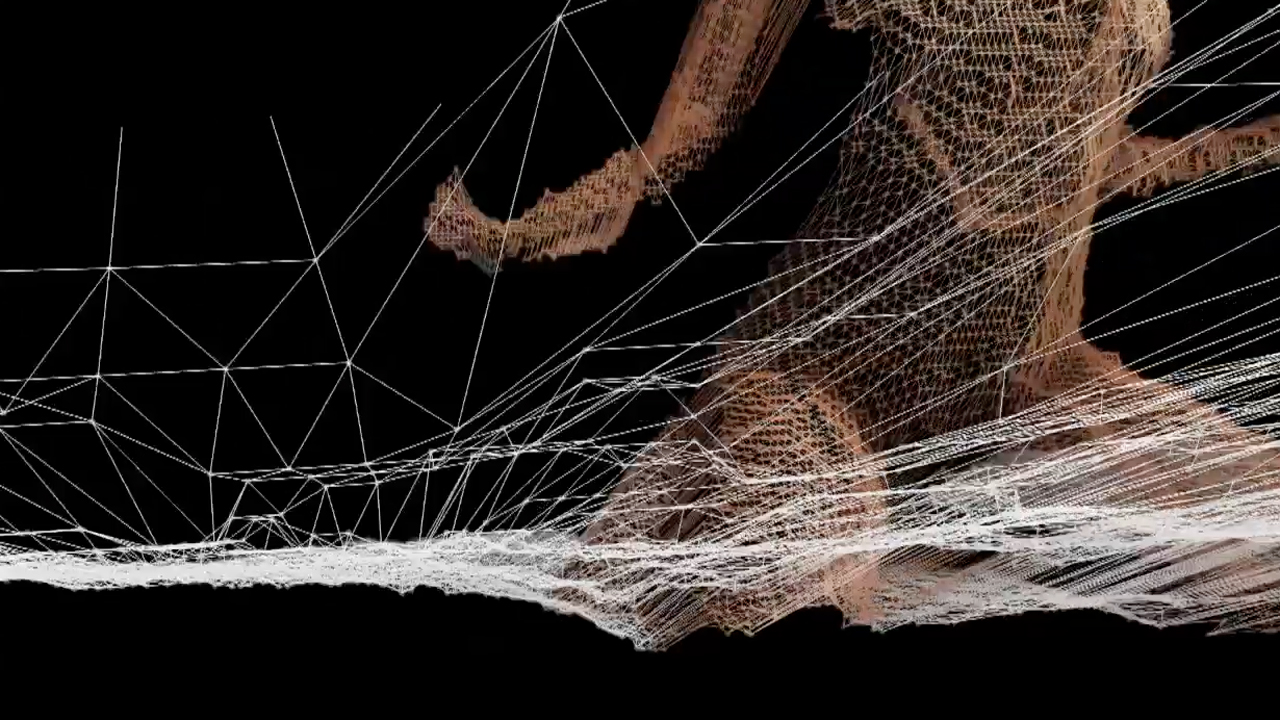How would a computer perceive an act so non-technological as humans having sex? There’s no particular appeal in bare skin, genitalia, or penetration for a machine; pornography, like any other piece of digital media, is just a series of zeroes and ones translated into pixels and colors on a screen. But Spanish artist Alejandro Gomez-Arias has used tools and tricks originally developed for video games to shoot an explicit, albeit pretty abstract, short film called Love Is All that just might appeal as much to machines as it does to us.
 Gomez-Arias’s piece was on display at “RESOLVE,” a pop-up exhibition in Williamsburg organized by James George and Alexander Porter, artists who have pioneered the use of the Kinect, the Microsoft Xbox 360 camera equipment that Gomez-Arias also employed. We covered the exhibition in ANIMAL’s ANIMAL’s profile of the duo and the RGBD Toolkit, software that George developed to mix Kinect data with the visuals from a normal camera.
Gomez-Arias’s piece was on display at “RESOLVE,” a pop-up exhibition in Williamsburg organized by James George and Alexander Porter, artists who have pioneered the use of the Kinect, the Microsoft Xbox 360 camera equipment that Gomez-Arias also employed. We covered the exhibition in ANIMAL’s ANIMAL’s profile of the duo and the RGBD Toolkit, software that George developed to mix Kinect data with the visuals from a normal camera.
Love Is All is a four-minute and 30-second piece that includes a brief strip tease followed by a variety of sexual positions between a young man and woman, isn’t like any porn you’ve ever seen before. It’s not glossy or high budget, and there aren’t any smoothed-over or surgically enhanced breasts or other body parts. It’s pixelated, but not in the way a clip streamed over a bad internet connection in your parents’ house is. Instead, the two participants in Love Is All are turned into hazes of flesh-colored dots arranged into skeletal polygons set against a pitch-black background. They’re ghostly forms in a world more digital than physical.

What makes the piece even more interesting is that one of the people in the video is actually the artist and the co-star his girlfriend. She was initially hesitant to be on camera, as might be expected when one is planning to turn a homemade sex tape into an art project and publish it online.

“I wanted the gestures, movements, and the relationship between the two people to be as real as possible,” the artist wrote to me in an email. “I did not find anyone who would be recorded having sex, so I decided to do it myself.” His girlfriend wasn’t convinced.
“At first she was not sure, but after seeing the results and the magic of RGBD she accepted,” Gomez-Arias explained. The images you see are actually less video footage than pure data reassembled.
The dots that make up the actors’ bodies are derived from an infrared camera, the Kinect, which was originally designed for Microsoft’s Xbox 360 system to allow players to interact with their games by jumping around their living rooms, no controller needed.
The Kinect uses a technique called “structured light” to judge where the player is. The machine projects a known geometric pattern in infrared light on to the area it’s scanning and detects how the pattern deforms when hitting objects in space, calculating depth and distance through a triangulation process in conjunction with a normal camera.

The Kinect information is mixed with footage from a normal digital camera that provides the colors visible in the end product. That mixing happens with James George’s RGBD Toolkit. The software allows the user to make shots and compositions that were before impossible because it makes the camera’s physical position in space irrelevant. RGBD uses the Kinect data to render an imagined shot from any angle, tracking at any speed in any direction, and zoomed in to any degree. That’s why it’s possible for Gomez-Arias to arrange a shot through the bed sheet, or grab a between-the-legs close-up without ever shifting the camera.
Gomez-Arias obviously appreciates the technological capabilities of the Kinect in terms of filmmaking, but it was philosophy that originally led him to the idea to shoot pornography. He decided to make a video that reflected on a quote from the philosophers Felix Guattari and Gilles Deleuze’s book, A Thousand Plateaus: “Every love is an exercise in depersonalization on a body without organs yet to be formed.”

“I thought it was very poetic, working with the idea of creating bodies to be constructed and deconstructed in the sex act,” the artist explained. Visualizing the process sketched in the quote, the figures in the video are broken down and remade in real time as the Kinect data and the digital camera footage ebb and flow.

Love Is All is undeniably sexy, just not in a normal sense of the word. With the sheer audacity of its aesthetics, it shocks us out of our internet-induced erotica stupor and forces us to reconsider digital pornography not as a cheap, disposable experience but as a medium capable of reflecting on the virtually augmented state of contemporary human sexuality. We already have virtual sex through chat windows or over Skype. We flirt with each other via OKCupid, sexts, and emoji. It’s been a long time since sex was purely physical.
Gomez-Arias’s video reveals this intersection of the corporeal and the digital, underlining the impact that computers have had on how we view our own bodies, especially in this most intimate of acts. Looking through computer eyes back at ourselves, we see a pornography for the future.

For more about the RGBDToolkit, read ANIMAL’s recent interview with creators James George and Alexander Porter here. Here’s a Vine of the piece in action at “RESOLVE.”


